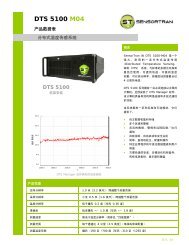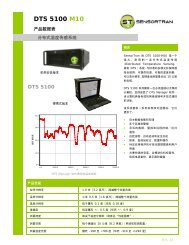Download PDF - SensorTran
Download PDF - SensorTran
Download PDF - SensorTran
You also want an ePaper? Increase the reach of your titles
YUMPU automatically turns print PDFs into web optimized ePapers that Google loves.
Tech NotesProduct<br />
Development<br />
DTS Today<br />
While DTS has been used traditionally for oil<br />
well monitoring, the recent development of longrange<br />
capabilities has led to an increased acceptance<br />
in applications related to pipelines and power cables.<br />
In the past, the DTS industry was viewed<br />
as a niche market understood only by a small<br />
group of “white glove” scientists and highly<br />
skilled technicians. Specifically, the DTS<br />
industry had been unable to grow rapidly due<br />
to the product’s complexity, especially during<br />
deployment and calibration of the systems.<br />
Moving DTS setup, calibration, operation,<br />
and ongoing analysis out of the hands of those<br />
same “white gloves”, and into the “leather<br />
gloves” in field crews is a critical shift that is<br />
now making DTS technology more accessible<br />
to all of these industries. Over the last year,<br />
the components were introduced to create an<br />
active plug and play solution for DTS, which<br />
features the following capabilities:<br />
The ability for field engineers to install<br />
and calibrate the DTS on site without needing<br />
an expert — the system calibrates itself; The<br />
ability of the system to react to and adjust for<br />
fiber attenuation caused by a shifting pipeline;<br />
andAuto-correcting and continuous verification,<br />
allowing the system to operate with little/<br />
no operator involvement.<br />
New Standards Organization<br />
While DTS operation is increasingly simplified,<br />
understanding the intricacies of the<br />
specification process and performance parameters<br />
can be confusing to newcomers. Several<br />
first-of-their-kind industry initiatives, including<br />
the creation of a standards organization<br />
are under way. For example, <strong>SensorTran</strong> and<br />
J-Power Systems (a subsidiary of Sumitomo<br />
Corp.) have joined together to create the<br />
International Distributed Optical Performance<br />
Testing Standards Association (IDOPTS). The<br />
goal of IDOPTS is to help buyers and users<br />
understand what the key specifications are,<br />
how they compare across manufacturers, and<br />
how the specifications are formulated to create<br />
standard testing procedures.<br />
Future Of DTS<br />
As DTS technology becomes a standard component<br />
for large asset monitoring applications —<br />
pipeline monitoring, oil and gas thermal recovery<br />
and implementation of the Smart Grid — manufacturers<br />
are continuing to add functionality and<br />
capabilities that ease installation and provide<br />
more value. Within the next year, advances in<br />
distributed fiber optic monitoring technology<br />
will enable the measurement of strain, corrosion<br />
and temperature using a single fiber probe.<br />
Being able to monitor multiple conditions with<br />
a single cable installation and a single interrogation<br />
unit will drive up ROI and promote efficient,<br />
consolidated data collection.<br />
Also on the near-term horizon are networked,<br />
lower-power, small footprint versions of DTS<br />
systems, which are specifically designed for<br />
pipelines and similar applications where groups<br />
of units are to be deployed outside in remote<br />
areas. These DTS systems are solar powered —<br />
allowing for outdoor mounting — can be run<br />
remotely and are autonomous. This means no<br />
operator intervention is required to collect, analyze<br />
and transmit decision-support information.<br />
To achieve widespread adoption, providers must<br />
continue to push the DTS technology envelope.<br />
Bringing scientific breakthroughs into the marketplace<br />
at a rapid pace will fuel sustained growth<br />
within the industry. P&GJ<br />
Author: Kent Kalar is CEO and president of<br />
<strong>SensorTran</strong>. He joined the company in 2004.<br />
From 1998-2003 he served as president and<br />
CEO of Extreme Devices, Inc., a semi-conductor<br />
fabrication company that produced widebandgap<br />
devices. Before Extreme Devices, he<br />
was vice president-business development at<br />
SPEC where he was responsible for strategic<br />
planning, generating value from existing intellectual<br />
property, and commercializing SPEC’s<br />
technologies and products. He earned an MBA<br />
from the Carlson School of Business at the<br />
University of Minnesota and a B.S degree in<br />
electrical engineering from Kettering University<br />
(formerly General Motors Institute)<br />
74 Pipeline & Gas Journal / May 2008 / www.pgjonline.com





